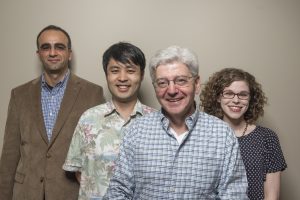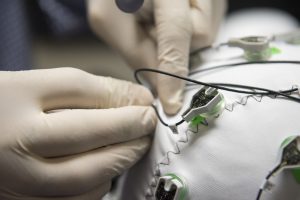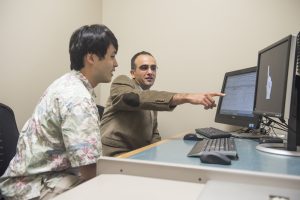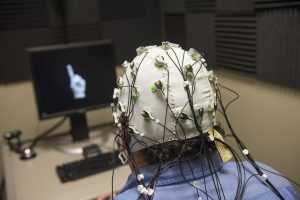
UA Adds Ed Neuroscience Concentration
By David Miller
Photos by Jeff Hanson
In a lab in the Tom Barnes Education Building on the Bryce Campus at The University of Alabama, Dr. Firat Soylu prepares an electroencephalography cap to be worn by a test participant.
He makes sure all plugs and wires are fastened to the white, stretchy EEG cap, which resembles a rugby helmet or swim cap. Once the device that reads the brain activity transmitted from the cap is calibrated and all connections are checked, Soylu leaves the sound-dampened room and enters an adjacent room where he’ll begin tests and record the participant’s brain activity.
The participant views, via a computer monitor, a series of gestures associated with how we count using our fingers. He responds to each gesture via a game controller while Soylu collects the data next door.
Number processing may seem like an obscure research focus to most, but it’s how we all learned to count as children. We differ, though, in which hand we use and which fingers we use to gesture numbers.
There’s neural data that could explain how we process unconventional number gestures, which hemisphere of the brain we use to process the gestures and possible details about inter prejudice of math educators.
“There are many studies showing that those indicators can be of critical value for future mathematical performance,” Soylu said. “We’ll also look at other populations, like autistic children who have problems recognizing gestures.”
This neuroscience study is what Soylu envisioned when he arrived at The University of Alabama three years ago and began planning what is now the Embodied Learning Design and Educational Neuroscience Lab. Soylu, an assistant professor of educational psychology in the UA College of Education, is part of a small group of faculty who are members of an emerging research field: educational neuroscience.
Soylu and Drs. Lisa Hsin and Hyemin Han, who joined the department earlier this year, hope to implement the same neuroscience technology and philosophies that have heavily influenced psychology research into teacher education and training.

Soylu said he was impressed with the enthusiasm of Dr. Peter Hlebowitsh, dean of the UA College of Education, and educational psychology faculty Drs. Rick Houser and Steve Thoma, whose work with Transcranial Direct-Current Stimulation several years ago marked the beginning of a push to create an ed neuroscience concentration and begin training graduate students at UA.
“They were enthusiastic about creating an environment to conduct research that bridges education and cognitive neuroscience, which is rare,” Soylu said. “There aren’t that many universities that catch onto this trend. In other places, you have to fit yourself into one area – education researcher or cognitive scientist. But it’s completely acceptable here to do both. That’s the nature of the work. UA has a potential to be one of the leading institutions in this emerging research.”
‘There was so much energy’
In 2013, Houser and Thoma collaborated on a study in which they used tDCS to explore a link between low-current brain stimulation, different brain cortexes and academic performance.
Shortly thereafter, the duo began attending neuroscience conferences across the country. They were immediately greeted by thousands of young, energetic scientists explaining their research and showcasing new technology to one another, laying the groundwork for future research partnerships.
“We’d seen some of the papers coming out of a lab in MIT where they were using certain techniques to understand people’s moral judgments at the neuro level,” Thoma said. “We thought that was interesting, and one thing led to another. Rick and I went to the Society for Neuroscience conference, and we were blown away. The energy at that conference was something I’ve never experienced. The Society for Neuroscience was very young, and the energy there was unbelievable.”
It was exciting and a broader picture of what their limited experience with neuroscience could be. Both Houser and Thoma were already excited at the possibilities after the preliminary results of their tDCS study. After all, using electrical stimulation, which is painless and harmless, to boost higher order math performance could revolutionize the way students study and prepare for tests. But noticeably absent at the large neuroscience conventions were actual educational neuroscientists.
“It’s blossomed so much, and there are so many people who are interested in this, but if you look at the sessions, there’s nothing on educational neuroscience,” Houser said. “Thousands of sessions. There’s a separate, small conference for ed neuroscience, but it hasn’t hit the larger neuroscience conferences. When that happens, it will help advance the field. There are so many undergraduates and people interested in neuroscience who are looking for their own niche.”
Thoma, Houser and Hlebowitsh have positioned UA to fill the immediate voids in graduate training and ed neuroscience research, which they hope will make the College a leader when the field fully blossoms.
They started by hiring Soylu, who had completed a post-doctoral fellowship at Northwestern University in 2013. Han and Hsin later joined the faculty, and two more researchers are expected to join in the next year. The College has since added a graduate-level ed neuroscience concentration to its ed psych program.
The three faculty members each have their own “niche” that Houser noted when he and other hiring committee members began the searches. While Soylu studies mathematical cognition and scientific reasoning, Han researches the neural correlates in moral judgment and how to apply the findings from neuroscience to K-12 interventions.
Hsin, who was trained as a cognitive scientist at Johns Hopkins University, studies the social and cognitive strengths and weaknesses of bilingual school children and how to boost their academic performance.

Hsin’s lab – the Education and Cognitive Science Lab – will be located at Capital Hall on the Bryce Campus, which will generate novel data around language and literacy development from early childhood through adolescence.
Hsin’s research focuses on children growing up in homes where English is not the main language spoken — a fast-growing population in the U.S., and one that she contends can tell us a great deal about human cognition and learning in a broader sense as well.
“The lab will supplement traditional educational research techniques with psycholinguistic and cognitive psychological data to explore, for example, the development of argumentative writing in children from language-minority homes,” Hsin said.
“On this critical issue, the work of the ECS Lab is to understand the social and cognitive processes that underlie the construction and production of considered, mature arguments, and ultimately to apply our findings in developing curricular interventions that help schoolchildren learn how to mold content worth knowing into ideas worth defending.”
In all its forms, educational neuroscience at UA takes seriously the charge of translating the nuances of lab-based research into tools that can take on classroom realities, in Tuscaloosa and around the nation, Hsin added.
Time, money and technology
Neuro-imaging equipment isn’t cheap.
It’s one of two significant hurdles to universities establishing and furthering ed neuroscience programs. Startup money for new faculty is typically lower in education than it is in STEM disciplines, which contributes to the slow emergence and impact, Houser said.
The most significant piece of equipment is a functional magnetic resonance imaging machine, or fMRI, which is a procedure that uses MRI technology to measure brain activity by detecting changes associated with blood flow.

The machines can cost upward of $2 million. The nearest is at the University of Alabama at Birmingham, where UA faculty do their imaging. While that cost is on the high end of the scale, smaller, more specific equipment, like eye-tracking devices can cost up to $50,000.
Though fMRI tests are conducted roughly an hour away from campus, that location serves as a hub for researchers from other universities in the state to lecture and share data.
The ed neuroscience faculty hope a collaborative approach will help grow the program at UA. And they’re off to a solid start, as Houser has built research collaborations with UA’s Center for Advanced Public Safety, and Soylu has started a brain & cognitive sciences email list with faculty in psychology, anthropology and communication.
Thoma said it’s the first time he’s seen a consistent interest, regardless of field, across departments, colleges and universities.
“Philosophy is the start – we’re interested in positive youth development, in general, and how to assist students to flourish in classroom settings,” Han said. “I believe that, with this program, we can be the core for interdisciplinary endeavors and gathering a snowball of scholars in different departments who are interested in the same topics.”
The impact
Houser said it will take five to 10 years for ed neuroscience data to impact teacher education, which will largely be achieved through continued advances in technology that allow researchers to conduct experiments in natural classroom settings.
Houser and Thoma, as part of their tDCS study, outfitted students with the technology and measured their performance in class and in their lab.
“We get information from fMRIs, but how natural is it to get information from someone in a tube to respond to a learning task?” Houser asked. “It isn’t, and that has to take place.”
The missing link in ed neuroscience’s slow emergence has been the unsuccessful interpretation into education, Soylu said. There’s a divide between education research, which is more sociocultural than neuroscience, he said.
“They say ‘you find all these interesting things about human cognition, but what does it mean for classroom practice?’” Soylu said. “’What does that mean for a math teacher?’ Nothing right now, but one of the things holding it back is there aren’t that many people who can do that interpretation. There are neuroscientists who are good at what they’re doing, but they don’t knowing anything about education.
“It will take time – we need to educate grad students, and that’s what we’re doing here. Our grad students are learning how to do cognition research, but they’re also educational psychologists. So, hopefully this new generation of researchers will be better at that.”
